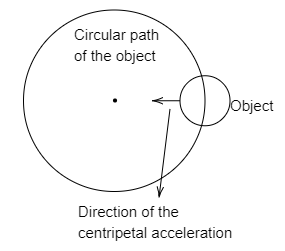
Define centripetal acceleration. Derive an expression for the centripetal acceleration of a particle moving with uniform speed $v$ along a circular path of radius $r$. Give the direction of this acceleration.
Answer
563.4k+ views
Hint
The centripetal acceleration will occur due to the centripetal force, which mostly occurs in the circular motion of the object. The centripetal acceleration is also called radial acceleration. The centripetal acceleration acts towards the centre of the circular path.
Complete step by step answer
The centripetal acceleration is the type of acceleration which is due to the centripetal force of the body which is moving in the circular path. This centripetal acceleration will act towards the centre of the circular path. The centripetal acceleration is denoted by ${a_c}$.
Now, the centripetal force is given by,
$\Rightarrow F = \dfrac{{m{v^2}}}{r}$
Where, $F$ is the centripetal force, $m$ is the mass of the object, $v$ is the velocity or speed of the object and $r$ is the radius of the circular path.
The acceleration is given by,
$\Rightarrow {a_c} = \dfrac{F}{m}$
By substituting the centripetal force in the centripetal acceleration equation, then the centripetal acceleration is written as,
$\Rightarrow {a_c} = \dfrac{{\left( {\dfrac{{m{v^2}}}{r}} \right)}}{m}$
By cancelling the same terms in the above equation, then the above equation of the centripetal acceleration is given as,
$\Rightarrow {a_c} = \dfrac{{{v^2}}}{r}$
Thus, the above equation shows the centripetal acceleration due to the centripetal force acting on the object which is moving in the circular path.
And when the object is moving in the circular path the velocity of the object always acts tangent to the circular path and the centripetal force acts towards the centre of the circular path.

Note
When a body is in uniform circular motion, its direction is changed continuously when the speed of the object is constant. When the velocity of the object changes continuously, there is an acceleration in the circular motion, that acceleration called centripetal acceleration.
The centripetal acceleration will occur due to the centripetal force, which mostly occurs in the circular motion of the object. The centripetal acceleration is also called radial acceleration. The centripetal acceleration acts towards the centre of the circular path.
Complete step by step answer
The centripetal acceleration is the type of acceleration which is due to the centripetal force of the body which is moving in the circular path. This centripetal acceleration will act towards the centre of the circular path. The centripetal acceleration is denoted by ${a_c}$.
Now, the centripetal force is given by,
$\Rightarrow F = \dfrac{{m{v^2}}}{r}$
Where, $F$ is the centripetal force, $m$ is the mass of the object, $v$ is the velocity or speed of the object and $r$ is the radius of the circular path.
The acceleration is given by,
$\Rightarrow {a_c} = \dfrac{F}{m}$
By substituting the centripetal force in the centripetal acceleration equation, then the centripetal acceleration is written as,
$\Rightarrow {a_c} = \dfrac{{\left( {\dfrac{{m{v^2}}}{r}} \right)}}{m}$
By cancelling the same terms in the above equation, then the above equation of the centripetal acceleration is given as,
$\Rightarrow {a_c} = \dfrac{{{v^2}}}{r}$
Thus, the above equation shows the centripetal acceleration due to the centripetal force acting on the object which is moving in the circular path.
And when the object is moving in the circular path the velocity of the object always acts tangent to the circular path and the centripetal force acts towards the centre of the circular path.

Note
When a body is in uniform circular motion, its direction is changed continuously when the speed of the object is constant. When the velocity of the object changes continuously, there is an acceleration in the circular motion, that acceleration called centripetal acceleration.
Recently Updated Pages
Master Class 12 Business Studies: Engaging Questions & Answers for Success

Master Class 12 Economics: Engaging Questions & Answers for Success

Master Class 12 English: Engaging Questions & Answers for Success

Master Class 12 Maths: Engaging Questions & Answers for Success

Master Class 12 Social Science: Engaging Questions & Answers for Success

Master Class 12 Chemistry: Engaging Questions & Answers for Success

Trending doubts
What is meant by exothermic and endothermic reactions class 11 chemistry CBSE

Which animal has three hearts class 11 biology CBSE

10 examples of friction in our daily life

One Metric ton is equal to kg A 10000 B 1000 C 100 class 11 physics CBSE

1 Quintal is equal to a 110 kg b 10 kg c 100kg d 1000 class 11 physics CBSE

Difference Between Prokaryotic Cells and Eukaryotic Cells




